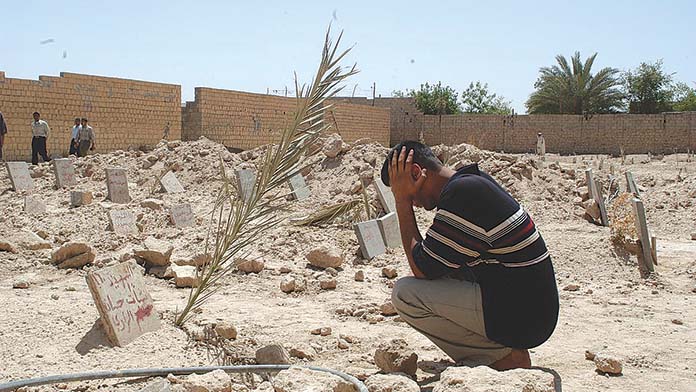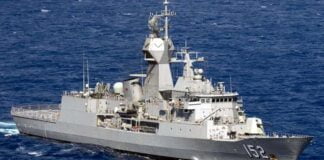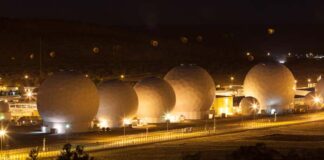Mark Gillespie looks at the chaos and death the US unleashed on Iraq following the invasion in 2003—and why we need a new movement against militarism and war
Twenty years ago on 20 March 2003, the so-called “coalition of the willing”—the US, Britain, Australia, and Poland—invaded Iraq. “Our mission”, said the then US President George W. Bush, is “to disarm Iraq of weapons of mass destruction, to end Saddam Hussein’s (Iraq’s President) support for terrorism, and to free the Iraqi people”.
But rather than free people, the only thing achieved in Iraq was the devastation of a whole country of 27 million people. Hundreds of thousands died, millions were displaced, and a new system of sectarian politics was embedded that has produced communal conflict and ethnic cleansing that continues to this day.
Today our rulers are preparing for war against China, as the US faces a major challenge to its position of global pre-eminence. Building a new movement against war is pressing.
In 2003, the US was the world’s sole unchallenged superpower. Policy makers within the Bush administration dreamed of flexing their power to make the 21st century another “American century”.
The 9/11 bombing of the World Trade Centre in New York in 2001 and the declaration of the so-called “War on Terror” provided the excuse to first invade Afghanistan and then Iraq, an oil-rich country at the centre of the strategically important Middle East.
The US wanted “regime change” in Iraq to cement US global dominance. Seizing control of the country’s oil reserves was meant to allow the US to dictate terms to China and Europe, both heavily dependent on Middle Eastern oil.
“American leadership is good both for America and for the world,” claimed Bush. In reality it was a war of naked US imperialism.
The war was based on lies. Saddam Hussein, we were told, had links to the terrorist group Al Qaeda, and threatened the world with an arsenal of biological and chemical weapons of mass destruction (WMDs). These were complete fabrications. No links with Al Qaeda were ever found, nor were any WMDs discovered.
On the weekend of February 14-16, leading up to the invasion, more than 30 million people across the world marched against the war—the largest co-ordinated demonstrations in human history.
Australia was no exception with about a million people marching in capital cities and regional centres that weekend. When these marches failed to stop the war many people concluded that protests don’t work.
But mass movements can end wars. Protests helped put an end to the Vietnam War—but their high point were huge weekday Moratorium marches involving tens of thousands on strike against the war, causing disruption that cost business millions in lost profits.
In Russia in 1917, it took a revolution to get Russia out of the disastrous First World War.
What people failed to understand in 2003 is how military competition and war are central to the capitalist system. A march through city streets on a weekend was not about to break our rulers’ addiction to war. Those marches needed to be sustained and combined with industrial action to create the kind of social crisis governments could not ignore.
Democracy and death
Iraq was meant to become a beacon of democracy. “Iraqi democracy will succeed,” said Bush and “that success will send forth the news, from Damascus to Tehran, that freedom can be the future of every nation.”
Today Iraq is no beacon of democracy. The 2022 “Freedom of the World Index” rated Iraq as “not free” with a score of 29 out of 100. The Economist’s 2022 “Democracy Index” lists Iraq as “authoritarian”. It is listed as the 23rd most fragile state out of 179 on the 2022 “Fragile State Index”, just ahead of Libya and below Congo.
US troops were meant to be “welcomed as liberators”. But following the invasion the US had no serious plans for reconstruction or how to run the country and it descended immediately into looting and economic collapse. This generated massive popular opposition and led to the growth of an armed resistance movement that threatened to force US troops out of the country. They responded through encouraging sectarian divisions in order to divide and rule, which only fueled more death and destruction.
With the 2003 invasion came a neoliberal opening-up of the economy. This saw the transitional Coalition Provisional Authority led by US administrator and former businessman Paul Bremer begin deregulating and privatising the economy.
Unbridled capitalism was meant to rebuild the infrastructure destroyed by the invasion. But 20 years later Iraqis still suffer from regular power cuts and poor water supply. According to the UN, despite Iraq’s immense oil and gas reserves, about one third of the population live in poverty, while some 35 per cent of young people are unemployed.
When Tommy Franks, the US General in charge of the invasion, was asked by reporters about the number of deaths, he replied, “we don’t do body counts”. But others did. The prestigious medical journal, The Lancet, carried out an epidemiological study in 2006 that estimated about 600,000 Iraqis died in the first 40 months of war and occupation in Iraq, along with 54,000 non-violent but still war-related deaths.
In 2007, the British polling firm, Opinion Research Business, did 2414 face-to-face interviews and found that 20 per cent of people had had at least one death in their household as a result of the conflict, meaning an estimated 1,033,000 killed. And the death and destruction in Iraq continued long after these studies were completed.
Between 2003 and 2020, according to researchers at USA’s Brown University, 9.2 million Iraqis either became refugees or internally displaced people. In 2007, the UN estimated that about 40 per cent of Iraq’s middle class had fled and had no desire to return. The Iraqi Medical Association estimated approximately half of Iraq’s registered doctors fled the country in the years immediately following the 2003 invasion.
Even though US troops finally withdrew from Iraq in 2011, the refugee trauma continues today. “At the start of 2022”, according to World Vision, “at least 2.5 million people — including 1.1 million children — needed humanitarian assistance. This included 960,000 people — over 422,000 of them children — who were in acute need of emergency food, shelter, access to clean water, sanitation, and essentials”.
This humanitarian crisis wasn’t even acknowledged by the “coalition of the willing” that created it. They even demonised those fleeing the crisis. The Australian government under John Howard, a strong supporter of the war, locked up Iraqi asylum seekers (among others) in desert and offshore detention centres.
Sectarianism
Between 2006 and 2008, Iraq descended into a sectarian-based civil war that tore apart families and neighbourhoods that had once lived together harmoniously. What fueled this civil war was the “muhasasa”, a system of sectarian power-sharing imposed on Iraq following the invasion.
Every election since 2004 has been based on sectarian parties. The system empowered a bloc of Shia parties backed by neighbouring Shia Iran. This along with other decisions alienated much of Iraq’s minority Sunni community, allowing Al Qaeda in Iraq (a Sunni-based terrorist group) to get a foothold for the first time.
In 2006, Al Qaeda in Iraq bombed the al-Askari Mosque, one of Shia Islam’s holiest sites and Iraq descended into a spiral of retaliatory violence and the establishment of sectarian-based militias. Every major political party in Iraq now has their own militia.
The Bush administration responded to the rising civil war with a “surge” of troops in 2007 that built walls around communities and co-opted sections of the Sunni community. But violence flared again in 2014 when Islamic State (ISIS), a descendant of Al-Qaeda in Iraq, took over much of western and northern Iraq.
Once again the US intervened, this time with a bombing campaign, dropping 105,000 bombs and missiles on Iraq and Syria and reducing Mosul and other places to rubble. Meanwhile, sectarian-based ground forces, now officially incorporated into the Iraqi state security forces via the Popular Mobilization Forces, fought ISIS on the ground.
The 2003 invasion also produced sectarianism and instability throughout the region as Sunni-led Saudi Arabia competed with Shia-led Iran. This rivalry has had tragic consequences in Yemen, Lebanon, Syria and other parts of the Middle East.
Rebellion
In 2019, a mass movement, the “Thawrat Tishreem” (October revolution), erupted in Baghdad and across southern Iraq. Demonstrations by Iraq’s youth, in spite of heavy repression from state forces and militias, forced the Prime Minister, Adel Abdul-Mahdi, to resign.
The demonstrators were angry about rising unemployment, endemic corruption, foreign influence and the failure of the government to provide the most basic services. They also called for an end to “muhasasa”, the system of sectarian power-sharing. All of these problems were either created or exacerbated by the 2003 invasion.
Before the war it was said that Saddam Hussein was such a ruthless dictator that it was impossible for the Iraqi people to organise to resist, so that democracy could only be brought to them with drones, missiles and tanks. But in the 2011 Arab Spring mass protests swept away numerous dictators across the region. The development of “Thawrat Tishreem”, a secular movement of predominantly Shia youth against the Shia establishment, shows that mass movements in Iraq are the hope for the future too.
Twenty years on, our rulers are once again banging the drums of war against China, arming themselves with nuclear submarines and pouring weapons into Ukraine. The carnage the US and Australia were prepared to unleashed on Iraq for profit and power is a reminder of our rulers’ real aims, as well as why we need to continue the struggle against militarism and war.






